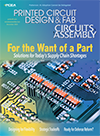Features Articles

Or even mildly irritated. So watch those catchphrases.
As we move into 2021, I resolve to renew my approach to doing business, call things as they really are, and exile all my peeves into permanent residence, where they belong, in their appropriate circle of Hell, apropos Dante Alighieri.
That’s right: we’re talking Inferno.
Flames have consequences.
Nine circles. Nine gripes. All therapy.
In ascending order of severity.
To continue reading, please log in or register using the link in the upper right corner of the page.

Needed: Methods to best predict and adjust to demand spikes.
Any supply-chain management executive will likely tell you that 2021 is 2020 on steroids. Reason: While 2020 had supply-chain disruption, the worst part of that disruption was followed by drops in customer demand due to Covid-19-related lockdowns, so the situation never worsened beyond spot shortages or transportation delays. This year, pent-up consumer demand combined with historic low interest rates supporting consumer spending is spiking product demand in multiple industries as consumers make purchases they delayed in 2020. 5G infrastructure is rolling out, demand has increased for electric vehicles, which have substantially more electronic components per car, and Covid-19 continues to drive higher medical equipment production. As a result, demand variations are changing schedules weekly. At the same time, constraints developing in the materials market are driving higher prices and longer lead-times. Transportation and freight resources are stretched, and pricing and lead-times are increasing. Covid-19 continues to cause some level of disruption as hot zones develop around the world. In short, 2021 will be a year where multiple variables are constantly in flux.
To continue reading, please log in or register using the link in the upper right corner of the page.

For real-time and predictive interventions, smart patches are in style.
For many of us in the technology sector, markets for high-tech products have remained resilient in the face of the effects of the pandemic. Despite lockdowns and restrictions, businesses are finding innovative ways to continue operating safely. Indeed, some seem to be thriving.
Gartner predicts the wearables market will grow 18% in 2021, reaching $81.5 billion. Ear-worn devices represent almost 50% of this market, with the current strong sales attributed to the WFH trend – as people upgrade from standard headphones for video conferencing – and the latest smartphones that have no 3.5mm jack.
Gartner notes, however, the increasing contribution of smart patches in the wearables space, rising to third in importance as sales of wristbands decline. This technology has ample potential to realize innovations in fields such as medicine and wellbeing that are so far undiscovered.
Bringing together multiple exciting technologies, such as flexible electronic materials, miniature sensors capable of detecting movement and various biomarkers, and micro-needles to deliver medicines when needed, smart patches are already changing healthcare. Conditions such as diabetes can be managed by detecting glucose levels in sweat on the surface of the skin and automatically injecting the appropriate quantity of insulin through an array of micro-needles. Researchers in the UK have considered similar patches to administer coronavirus vaccines.
To continue reading, please log in or register using the link in the upper right corner of the page.

Solving the age-old dilemma between design and manufacturing.
Developing a new product or process – or even aggressively refining them – is a juggle of “wants” and “needs.” As manufacturers in an industry that constantly pushes the envelopes of performance, real estate, and – yes! – cost, our industry is precisely where the rubber meets the road in reconciling needs and wants.
Manufacturing is a curious profession that often relies on older equipment, processes and employee skills to produce cutting-edge “new” products. The catalyst is, of course, people: people who design and people who take those designs and make functioning product. As smart, talented, dedicated and thoughtful as these people may be, however, they often fail to communicate the needs vs. the wants.
Indeed, it can be hard to know what’s on the other side of the hill.
To continue reading, please log in or register using the link in the upper right corner of the page.

What do you do when the very thing for which you’ve been asking, nay, begging for years actually materializes?
That would be US government support for the printed circuit board industry. And it’s coming in the form of real dollars, not just platitudes.
As we report in our digital edition this month, the US Partnership for Assured Electronics (USPAE), a subsidiary IPC formed last year to give it room to lobby on behalf of US members without running afoul of its international cohort, has as of late January garnered more than $42 million in taxpayer dollars to manage joint industry-academia programs to tackle electronics-related challenges.
How we’ve waited for this.
Going back to the 1990s, when I worked at IPC, we spent thousands of hours (and countless more dollars) vainly waving our hands in front of Congress’s collective face. And once a year, we would gather in Washington and run from office to office on Capitol Hill telling anyone and everyone how important the industry is. After, we would retreat to our hotel bars and pat each other on the back for a job well done. After many years of this, Congress even passed a resolution. “The PCB industry is important!” they said. “Hallelujah!” we rejoiced. Our souls were saved. Or so we thought. Then the OEMs packed up and moved their orders to Taiwan and China. Poof.
To continue reading, please log in or register using the link in the upper right corner of the page.

How to respond to supplier price increases.
Demand for printed circuit boards is going up. But so are production costs.
Raw PCB material pricing has jumped about 40% since June, with the exact increase dependent on material type. This price increase was inevitable and is, in fact, overdue.
During the early months of the Covid crisis, most PCB suppliers were hesitant to pass on their already-increasing material costs. But as China has rebounded faster from the Covid slowdown than the US and Europe, demand for production has escalated. PCB vendors are now more willing to pass higher material costs onto their customers. And the price increases are by no means over.
To continue reading, please log in or register using the link in the upper right corner of the page.
Press Releases
- Altus Group Expands Aftersales Team to Its Largest Size to Date
- Incap Estonia Invests in New Flying robe System to Advance Production Performance
- Critical Manufacturing Partners with Canonical to Expand Cloud-Native Deployment Options for Manufacturers
- Heller Industries Becomes the Latest Partner to Join THE SMT FUTURE EXPERIENCE


